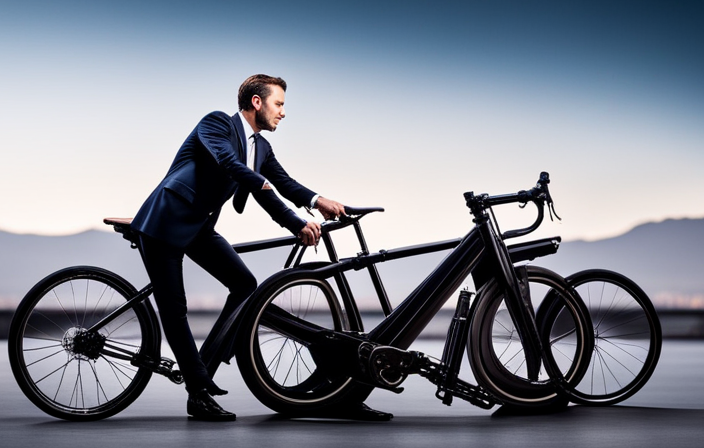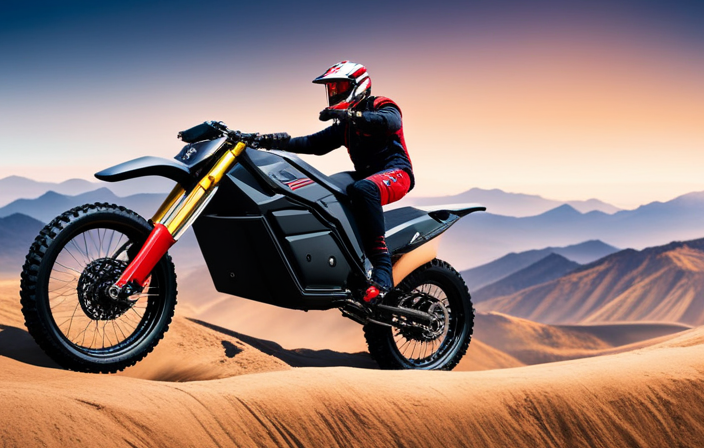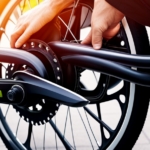Rev up your ride and revolutionize your cycling experience with the electrifying transformation of your ordinary bike into an electric powerhouse.
This comprehensive guide will equip you with the knowledge and tools you need to embark on this exciting journey.
From assessing your bike’s compatibility to installing the electric conversion kit and fine-tuning the transformation, I’ll walk you through each step, ensuring a smooth and successful transition.
Get ready to conquer the streets with your newly electrified bike!
Key Takeaways
- Increased speed and range
- Reduced environmental impact
- Cost savings compared to buying a new electric bike
- Health benefits from increased physical activity
Assess Your Bike’s Compatibility
Assess if your bike is compatible for conversion to electric. This step is crucial to determine whether your bike can handle the necessary modifications and upgrades.
Start by examining your bike’s frame and structure. Make sure it is sturdy enough to support the additional weight of the electric components. Check if your bike has enough space to accommodate a battery, motor, and controller. Upgrading bike components, such as the brakes and gears, may also be necessary to ensure a smooth and safe ride.
Converting your bike to electric offers several benefits, including increased speed, longer range, and reduced effort while pedaling.
Once you have assessed your bike’s compatibility, you can move on to gathering the necessary tools and materials needed for the conversion process.
Gather the Necessary Tools and Materials
When converting my bike into an electric one, I first need to purchase an electric conversion kit. This kit will include all the necessary components like a motor, controller, and wiring.
Additionally, I should gather basic tools such as wrenches and screwdrivers to help me with the installation process.
Lastly, I may also consider purchasing additional accessories like a battery and charger. These accessories will ensure a smooth and efficient electric biking experience.
Purchase an Electric Conversion Kit
To convert your bike into an electric one, consider purchasing an electric conversion kit. This kit is the essential component that will transform your regular bicycle into a powerful, eco-friendly electric bike. With a wide variety of options available in the market, it’s important to choose the right conversion kit for your specific needs. Look for a kit that is compatible with your bike’s frame and wheel size, and consider factors such as motor power and battery capacity.
There are several benefits to converting your bike into an electric one. First, it allows you to enjoy the convenience of motorized assistance, making uphill climbs and long distances much easier. Additionally, electric bikes are a greener alternative to traditional transportation methods, reducing your carbon footprint and helping to protect the environment.
Once you have chosen the perfect electric conversion kit, the next step is to gather basic tools such as wrenches and screwdrivers. These tools will be essential for the installation process, ensuring that everything is securely attached and functioning properly.
Gather Basic Tools such as Wrenches and Screwdrivers
Once you’ve chosen the perfect electric conversion kit, make sure to gather basic tools like wrenches and screwdrivers. These tools are essential for basic tool maintenance and can help you tackle common bike problems that may arise during the conversion process.
Wrenches will come in handy when you need to loosen or tighten bolts and screws, while screwdrivers will be useful for removing and attaching various components. It’s important to have a variety of sizes for both tools to ensure you can handle any task that comes your way.
Additionally, having these tools on hand will allow you to make adjustments and perform routine maintenance on your electric bike once it’s up and running.
With your basic tools ready, you can now consider additional accessories like a battery and charger, which we’ll discuss in the next section.
Consider Additional Accessories like a Battery and Charger
Now, it’s time to think about adding extra accessories such as a battery and charger for your electric conversion kit. When choosing a battery, it’s important to consider its lifespan and capacity. Opt for a high-quality battery that can provide sufficient power for your electric bike. Additionally, make sure to check the compatibility of the battery with your conversion kit.
To ensure a longer battery lifespan, it’s crucial to follow proper maintenance tips. Regularly charge your battery and avoid overcharging or completely draining it. Store the battery in a cool and dry place when not in use. Properly cleaning the battery terminals and checking for any signs of damage or corrosion is also essential. Remember, a well-maintained battery will greatly enhance the performance and longevity of your electric bike.
Now, let’s move on to preparing your bike for conversion by examining its components and making necessary adjustments.
Prepare Your Bike for Conversion
First, you’ll need to gather the necessary tools and materials to prepare your bike for conversion. Here are some tips for choosing the right conversion kit and common challenges you may encounter during the conversion process:
- Research different conversion kits to find one that suits your bike and riding needs.
- Consider the power and range of the motor, as well as the type of battery and charger required.
- Ensure the kit includes all the necessary components, such as a motor controller and throttle.
- Take measurements of your bike to ensure compatibility with the conversion kit.
Once you have all the tools and materials ready, you can start preparing your bike for the electric conversion. This involves removing any unnecessary components, such as the chain, gears, and derailleur, to make space for the motor and battery.
After completing these steps, you’ll be ready to install the electric conversion kit and begin enjoying your newly converted electric bike.
Install the Electric Conversion Kit
Now that we have prepared our bike for conversion, it’s time to move on to the next step: installing the electric conversion kit. This is where the real magic happens!
The electric motor installation is the heart of the conversion process. It’s important to follow the manufacturer’s instructions carefully, ensuring that the motor is securely attached to the bike frame.
Once the motor is in place, we can move on to connecting the battery. This step involves carefully wiring the battery to the motor, ensuring a secure and reliable connection. It’s crucial to double-check all connections and make sure everything is properly insulated to prevent any electrical mishaps.
With the electric motor and battery connected, we’re almost ready to hit the road with our newly converted electric bike. But before we do, we need to adjust and fine-tune the conversion to ensure optimal performance.
Adjust and Fine-Tune the Conversion
To optimize performance, it’s important to make necessary adjustments and fine-tune the electric conversion.
After installing the electric conversion kit, it’s time to focus on adjustment techniques and troubleshooting tips.
First, check the alignment of the motor and ensure it is securely fastened to the frame.
Next, adjust the tension of the drive belt or chain to prevent slipping.
Make sure the brakes are properly aligned and adjusted for optimal stopping power.
Additionally, fine-tune the throttle and pedal assist settings to suit your riding style.
If you encounter any issues, such as strange noises or poor battery performance, consult the troubleshooting guide provided with the conversion kit.
Remember, proper adjustments and fine-tuning will ensure a smooth and efficient ride.
Now, let’s move on to the next section and learn how to enjoy your electric bike to the fullest.
Enjoy Your Electric Bike
Once you’ve made the necessary adjustments and fine-tuned your electric conversion, it’s time to fully enjoy the benefits of your new electric bike.
The first and most obvious benefit is the ease of riding. With the electric motor assisting you, you’ll find that hills are no longer a challenge, and you can travel longer distances without getting tired.
Another benefit is the environmental impact. By riding an electric bike, you’re reducing your carbon footprint and helping to preserve the planet.
To maintain your electric bike, there are a few tips to keep in mind. Regularly check the tire pressure, as it can affect the performance of the bike. Also, keep the battery charged and clean the bike regularly to ensure optimal performance.
By following these tips, you can enjoy your electric bike to the fullest.
Frequently Asked Questions
How long does it take to convert a bike into an electric bike?
Converting a bike into an electric bike typically takes a few hours to a couple of days, depending on your experience and the complexity of the conversion. Necessary tools may include a motor kit, battery, controller, and basic hand tools.
Can I convert any type of bike into an electric bike?
Any type of bike can be converted into an electric bike, offering numerous advantages. Electric bikes are compatible with various bike models, allowing for a seamless transition to an eco-friendly and efficient mode of transportation.
Do I need any special skills or knowledge to convert a bike into an electric bike?
No special skills or knowledge are required to convert a bike into an electric bike. However, having a basic understanding of electronics and access to special tools for installation and maintenance is recommended. Additionally, knowledge of electric bike batteries is essential.
What is the average cost of converting a bike into an electric bike?
The average cost of converting a bike into an electric bike varies depending on whether you choose to do it yourself or hire a professional. DIY projects can range from $200-$1000, while professional conversions can cost $1000-$3000 or more.
Are there any legal requirements or restrictions for riding an electric bike?
There are legal requirements and restrictions for riding an electric bike. Electric bike regulations vary by country and state, but generally include age restrictions, speed limits, and the use of safety equipment. Safety concerns include proper maintenance, visibility, and following traffic laws.
Conclusion
In conclusion, converting my bike into an electric one was a challenging yet rewarding experience. Assessing my bike’s compatibility and gathering the necessary tools and materials were crucial steps in the process.
By preparing my bike for conversion and installing the electric conversion kit, I successfully transformed my bike into an electric one. Adjusting and fine-tuning the conversion ensured optimal performance.
Now, as I ride my electric bike, I can’t help but wonder, ‘Is there anything more exhilarating than effortlessly gliding through the streets, powered by my own creation?’ It’s a feeling of pure freedom and accomplishment that electrifies my every ride.
















